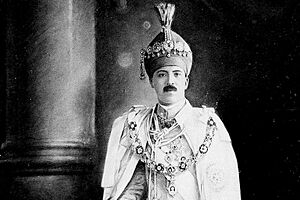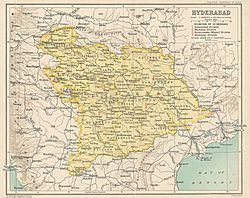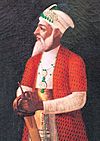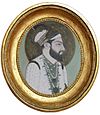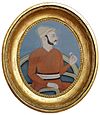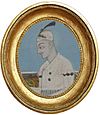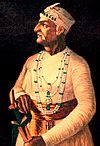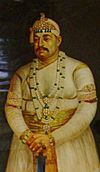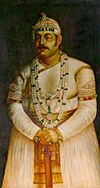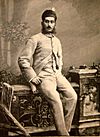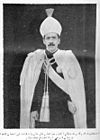Nizam of Hyderabad facts for kids
Quick facts for kids Nizam of Hyderabad |
|
|---|---|
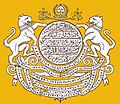
Coat of Arms of Hyderabad State
|
|
| Incumbent | |
| Mukarram Jah (pretender) | |
| Details | |
| Style | His Exalted Highness |
| Heir apparent | Azmet Jah |
| First monarch | Qamar-ud-din Khan |
| Last monarch | Osman Ali Khan |
| Formation | 31 July 1724 |
| Abolition | 17 September 1948 |
| Residence | Chowmahalla Palace |
| Pretender(s) | Mukarram Jah |
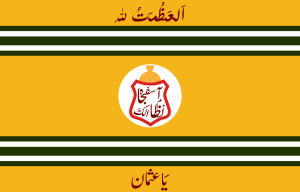
The bottom script reads Ya Uthman which translates to "Oh Osman".
The writing in the middle reads "Nizam-ul-Mulk Asaf Jah"
The Nizams were powerful rulers of the Hyderabad State in India. They ruled from the 18th century until the middle of the 20th century. The title Nizam of Hyderabad (or Niẓām ul-Mulk, also known as Asaf Jah) was given to the monarch of this large state. Today, the area of Hyderabad State is split between the states of Telangana, Maharashtra, and Karnataka.
The word Nizam means "Administrator of the Realm." It was the title inherited by Asaf Jah I. He was a top official under the Mughal Empire before he started his own independent kingdom in 1724.
The Asaf Jahi dynasty was the family line of the Nizams. It was started by Mir Qamar-ud-Din Siddiqi (Asaf Jah I). He worked for the Mughal Empire from 1713 to 1721. After the Mughal Emperor Aurangzeb died in 1707, Mughal control became weak. By 1724, Asaf Jah I became almost independent. Hyderabad later had to pay taxes to the Maratha Empire after losing some battles.
When the East India Company took control of much of India, they allowed the Nizams to keep ruling their state. The Nizams had power over Hyderabad until September 17, 1948. That's when Hyderabad became part of the new country of India.
The Asaf Jah dynasty had seven official rulers. However, there was a period of 13 years after the first Nizam when his sons and grandson ruled but were not officially recognized. The last Nizam, Mir Osman Ali Khan, lost power when India took over Hyderabad in 1948 during an event called Operation Polo.
Contents
Hyderabad State: A Powerful Kingdom
By the time it joined India, Hyderabad was the largest and richest of all the princely states. It covered a huge area of about 214,000 square kilometers. In 1941, about 16.34 million people lived there.
Hyderabad State had many things that made it unique. It had its own army, airline, and postal system. It also had its own railway network, telephone system, and radio station. The state even had its own money, called the Hyderabadi rupee.
The Nizams also gave important government jobs to people from different backgrounds. For example, Hindus served as Prime Ministers of Hyderabad and held other high positions.
History of the Nizams
What Does "Nizam" Mean?
The word Nizam comes from the Urdu language. It means "order" or "arrangement." This title was often given to important government officials. Nizam-ul-mulk means "Administrator of the Realm." This term came from the Persian language.
The Nizam Family's Origins
The Nizam family in India came from Abid Khan. He was a Persian from Samarkand. His family line is traced back to a Sufi saint named Shahab al-Din Abu Hafs Umar Suhrawardi.
In the 1650s, Abid Khan met Prince Aurangzeb in Deccan. Aurangzeb later became the Mughal Emperor. Abid Khan helped Aurangzeb in wars and became one of his favorite noblemen. His son, Ghazi Uddin Khan, married into another important Mughal family.
Mir Qamaruddin Khan, who started the Nizam line, was born from this marriage. He came from two very important families at the Mughal court.
Ghazi Uddin Khan became a general for Emperor Aurangzeb. He helped conquer the southern Indian kingdoms of Bijapur and Golconda Sultanate in 1686.
After Aurangzeb died, Mir Qamaruddin Khan was appointed governor of Deccan in 1713. He was given the title Nizam-ul-Mulk. Later, he became the prime minister of the Mughal Empire. However, he faced challenges and returned to Deccan. In 1724, he became a semi-independent ruler, starting the Nizam dynasty.
How the Nizams Ruled
In 1724, Asaf Jah I defeated his rivals and took control of the Deccan region. He named it Hyderabad Deccan. This began the Asaf Jahi dynasty. The rulers after him kept the title Nizam ul-Mulk.
The first Nizam never officially declared independence from the Mughals. He still used the Mughal flag. Even in Friday prayers, the sermon was said in Aurangzeb's name until 1948.
After Asaf Jah I died in 1748, there was a time of trouble. His sons fought for the throne, with help from neighboring states and European forces. Things became stable again when Asif Jah II became Nizam in 1762. In 1768, he signed a treaty with the East India Company. He gave them the coastal region in exchange for a yearly payment.
After the Mughal Empire weakened, the Maratha Empire grew strong in the Deccan. The Nizams fought many battles with the Marathas and often lost. They had to pay a regular tax called Chauth to the Marathas.
In 1805, after the East India Company won a war against the Marathas, the Nizam of Hyderabad came under British protection.
In 1903, the Berar region of Hyderabad was separated and joined with other British Indian areas.
The last Nizam, Mir Osman Ali Khan, became ruler in 1911. He was known as the richest man in the world during his time. The Nizams built many important things in Hyderabad, like railways, roads, and hospitals. They also brought electricity and developed irrigation systems. Most of the major public buildings in Hyderabad City were built when he ruled. He also strongly supported education and science, and he established Osmania University.
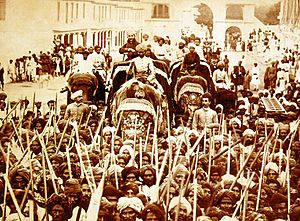
In 1947, when India became independent, the British government gave the 565 princely states three choices: join India, join Pakistan, or remain independent.
The End of the Dynasty
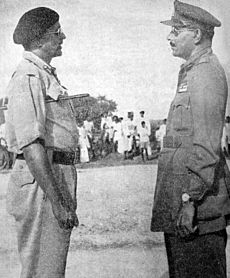
After India gained independence in 1947, the Nizam of Hyderabad decided not to join India or Pakistan. He wanted Hyderabad to be an independent state. However, the Government of India did not agree.
There were also problems with a group called Razakars. They wanted Hyderabad to join Pakistan and committed acts of violence against Hindu people. Because of this, the Indian government launched a military operation called Operation Polo. The Indian Army entered Hyderabad on September 13, 1948. They quickly defeated the Nizam's forces.
The Nizam surrendered on September 17, 1948. He announced the news on the state radio. He was forced to agree to Hyderabad joining the new country of India. This surrender marked the end of the Nizam dynasty's rule. Even after this, he became the Rajpramukh, a ceremonial governor, based on public vote.
Mir Osman Ali Khan, the last Nizam, died on February 24, 1967. Most Nizams are buried in royal graves at the Makkah Masjid in Hyderabad. However, the last Nizam, Mir Osman Ali Khan, wanted to be buried next to his mother at the Judi Mosque.
The Nizams' Great Wealth
During the Nizams' rule, Hyderabad became very rich. This was mainly because of the Golconda mines. These mines were the only source of diamonds in the world at that time, apart from South Africa. This made the 7th Nizam the richest person in the world.
The Nizams were given special titles by the British, like "His Exalted Highness" and "Faithful Ally of the British Government." They earned these titles for their help in wars like the Second Anglo-Mysore War and the Indian Rebellion of 1857. They were the only Indian princes to receive both these titles.
An example of their wealth is the Jewels of the Nizams. These amazing jewels were once shown in a museum but are now kept in a vault in Delhi. In 1948, Hyderabad state had about 17 million people and made a huge amount of money each year.
The state had its own money, the Hyderabadi rupee, until 1951. The last Nizam, Mir Osman Ali Khan, became one of the world's richest men by 1937. He was estimated to be worth billions of US dollars in today's money.
Important Institutions and Buildings
The Nizams built many important places and started many institutions. These included hospitals, schools, colleges, and universities. They also created their own local Hyderabad Civil Service, similar to the Indian Civil Service.
They built large reservoirs like Osman Sagar and Himayat Sagar to store water. They also started the survey work for the Nagarjuna Sagar Dam.
Other famous buildings they built include the Telangana High Court, City College, Public Gardens, Jubilee Hall, Asafia Library, the Assembly building, Niloufer Hospital, and the Osmania Arts College and Osmania Medical College.
Support for Culture and Religion
The Nizams also supported cultural and religious projects. In 1932, the 7th Nizam, Mir Osman Ali Khan, gave money to help publish the Mahabharata at a research institute in Pune. He also donated money to build a guest house there.
The Nizams also gave money to Hindu temples. For example, they donated to the Yadagirigutta temple and the Sita Ramachandraswamy temple, Bhadrachalam. The 7th Nizam also gave yearly grants to the Tirupati Balaji Temple and money for the rebuilding of the Sitarambagh temple.
Palaces of the Nizams
The Nizams built many beautiful palaces. Some of them are:
- Chowmahalla Palace - This was the official home for the early Nizams.
- Purani Haveli
- King Kothi Palace
- Mahboob Mansion
- Falaknuma Palace
- Bella Vista
- Hill Fort Palace
- Chiran Palace
- Saifabad Palace
- Hyderabad House, New Delhi
- Nizam Palace, Kolkata
List of Nizams of Hyderabad (1724–1948)
| Image | Titular Name | Personal Name | Date of birth | Nizam From | Nizam Until | Date of death |
|---|---|---|---|---|---|---|
| Nizam-ul-Mulk, Asaf Jah I نظامالملک آصف جاہ |
Mir Qamar-ud-din Khan | 20 August 1671 | 31 July 1724 | 1 June 1748 | ||
| Nasir Jung نصیرجنگ |
Mir Ahmed Ali Khan | 26 February 1712 | 1 June 1748 | 16 December 1750 | ||
| Muzaffar Jung مظفرجنگ |
Mir Hidayat Muhi-ud-din Sa'adullah Khan | ? | 16 December 1750 | 13 February 1751 | ||
| Salabat Jung صلابت جنگ |
Mir Sa'id Muhammad Khan | 24 November 1718 | 13 February 1751 | 8 July 1762 (deposed) |
16 September 1763 | |
| Nizam-ul-Mulk, Asaf Jah II نظامالملک آصف جاہ دوم |
Mir Nizam Ali Khan | 7 March 1734 | 8 July 1762 | 6 August 1803 | ||
| Sikander Jah, Asaf Jah III سکندر جاہ ،آصف جاہ تریہم |
Mir Akbar Ali Khan | 11 November 1768 | 6 August 1803 | 21 May 1829 | ||
| Nasir-ud-Daula, Asaf Jah IV ناصر الدولہ ،آصف جاہ چارہم |
Mir Farqunda Ali Khan | 25 April 1794 | 21 May 1829 | 16 May 1857 | ||
| Afzal-ud-Daula, Asaf Jah V افضال الدولہ ،آصف جاہ پنجم |
Mir Tahniyath Ali Khan | 11 October 1827 | 16 May 1857 | 26 February 1869 | ||
| Asaf Jah VI آصف جاہ شیشم |
Mir Mahbub Ali Khan | 17 August 1866 | 26 February 1869 | 29 August 1911 | ||
| Asaf Jah VII آصف جاہ ہفتم |
Mir Osman Ali Khan | 6 April 1886 | 29 August 1911 | 17 September 1948 (deposed) |
24 February 1967 | |
Family of the Last Nizam
The last Nizam had many children, including 16 sons and 18 daughters. The Asaf Jahi dynasty followed a rule where the eldest son would inherit the title, no matter who his mother was.
His oldest son was Azam Jah. He was the Prince of Berar. His second son, Moazzam Jah, married Princess Niloufer from the Ottoman Empire.
Family Tree of the Nizams
 I. Asaf Jah I, the 1st Nizam of Hyderabad (born 20 August 1671 – died 1 June 1748). He was a senior governor in the Mughal government. He defeated the Imperial forces and created his own independent state. He was confirmed in his rule on July 31. He made Hyderabad City his capital on December 7, 1724.
I. Asaf Jah I, the 1st Nizam of Hyderabad (born 20 August 1671 – died 1 June 1748). He was a senior governor in the Mughal government. He defeated the Imperial forces and created his own independent state. He was confirmed in his rule on July 31. He made Hyderabad City his capital on December 7, 1724.
 II. Nasir Jang, the 2nd Nizam of Hyderabad (born 26 February 1712 – killed 16 December 1750; ruled 1 June 1748 – 16 December 1750).
II. Nasir Jang, the 2nd Nizam of Hyderabad (born 26 February 1712 – killed 16 December 1750; ruled 1 June 1748 – 16 December 1750).- Sahibzadi Khair un-nisa Begum. Married Nawab Talib Muhi ud-din Mutasawwil Khan Bahadur, Muzaffar Jang:
 IV. Salabat Jang, the 4th Nizam of Hyderabad (born November 1718 – died 16 September 1763; ruled 13 February 1751 – 8 July 1762). He was removed from power by his younger brother and died in prison.
IV. Salabat Jang, the 4th Nizam of Hyderabad (born November 1718 – died 16 September 1763; ruled 13 February 1751 – 8 July 1762). He was removed from power by his younger brother and died in prison. V. Asaf Jah II, the 5th Nizam of Hyderabad (born 7 March 1734 – died 6 August 1803; ruled 8 July 1762 – 6 August 1803).
V. Asaf Jah II, the 5th Nizam of Hyderabad (born 7 March 1734 – died 6 August 1803; ruled 8 July 1762 – 6 August 1803).
 VI. Asaf Jah III, the 6th Nizam of Hyderabad (born 11 November 1768 – died 21 May 1829; ruled 6 August 1803 – 21 May 1829). He was the first Nizam to officially use the title Nizam.
VI. Asaf Jah III, the 6th Nizam of Hyderabad (born 11 November 1768 – died 21 May 1829; ruled 6 August 1803 – 21 May 1829). He was the first Nizam to officially use the title Nizam.
 VIII. Asaf Jah V, the 8th Nizam of Hyderabad, GCSI (born 11 October 1827 – died 26 February 1869; ruled 16 May 1857 – 26 February 1869). He was the first Nizam to rule under British influence. **
VIII. Asaf Jah V, the 8th Nizam of Hyderabad, GCSI (born 11 October 1827 – died 26 February 1869; ruled 16 May 1857 – 26 February 1869). He was the first Nizam to rule under British influence. ** IX. Asaf Jah VI, the 9th Nizam of Hyderabad GCB, GCSI (born 17 August 1866 – died 31 August 1911; ruled 26 February 1869 – 31 August 1911). He became ruler when he was young and ruled with full power from 1884. ***
IX. Asaf Jah VI, the 9th Nizam of Hyderabad GCB, GCSI (born 17 August 1866 – died 31 August 1911; ruled 26 February 1869 – 31 August 1911). He became ruler when he was young and ruled with full power from 1884. *** X. Asaf Jah VII, the 10th Nizam of Hyderabad and of Berar GCSI, GBE, Royal Victorian Chain (born 6 April 1886 – died 24 January 1967; ruled 31 August 1911 – 26 January 1950). He was given the title His Exalted Highness in 1918. He was the last ruling Nizam. His state was taken over by India in 1948. He served as a ceremonial governor until 1956. ****
X. Asaf Jah VII, the 10th Nizam of Hyderabad and of Berar GCSI, GBE, Royal Victorian Chain (born 6 April 1886 – died 24 January 1967; ruled 31 August 1911 – 26 January 1950). He was given the title His Exalted Highness in 1918. He was the last ruling Nizam. His state was taken over by India in 1948. He served as a ceremonial governor until 1956. ****- Azam Jah, Prince of Berar GCIE, GBE (born 21 February 1907 – died 9 October 1970). He was given the title His Highness the Prince of Berar. *****
 XI. Asaf Jah VIII, the 11th Nizam of Hyderabad and Berar (born 6 October 1933; 11th Nizam: 24 January 1967 – 28 December 1971; dynastic head and pretender since then). ******
XI. Asaf Jah VIII, the 11th Nizam of Hyderabad and Berar (born 6 October 1933; 11th Nizam: 24 January 1967 – 28 December 1971; dynastic head and pretender since then). ******- Azmat Jah (born 23 June 1960; appointed Prince of Berar and heir: 2002)
The daughters of the Nizams traditionally married young men from the Paigah family.
italics – These rulers are seen by most historians as not having full traditional authority during their time.
Places and Things Named After the Nizams
Many places and things are named after the Nizams, showing their lasting impact. These include:
- Nizamabad, a city and district in Telangana.
- Jamia Nizamia, a university.
- The Nizam College.
- The Nizam's Museum.
- The Nizam's Guaranteed State Railway.
- The Nizam's Institute of Medical Sciences.
- The Jewels of the Nizams.
- The Nizam Diamond.
- The Nizam Sagar, a large lake.
- HMAS Nizam, a ship.
- Nizamia observatory.
- The Nizam Club.
- The Nizam of Hyderabad necklace.
- The Nizam's Contingent, a military force.
- The Nizam Gate.
- The Nizam Palace in Kolkata.
- Government Nizamia General Hospital.
- H.E.H. the Nizam's Charitable Trust.
See also
 In Spanish: Nizam para niños
In Spanish: Nizam para niños
- Asaf Jahi dynasty
- History of Telangana
- History of Hyderabad, India
- Hyderabadi Muslims
- Osman Ali Khan
- Mukarram Jah
- Najaf Ali Khan
- Salar Jung family
- Raja Shamraj Bahadur


